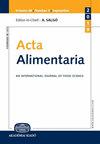绿茶对高果糖饮食大鼠血液和肝脏的保护作用
IF 1
4区 农林科学
Q4 FOOD SCIENCE & TECHNOLOGY
引用次数: 0
摘要
本研究旨在研究绿茶对高果糖饮食大鼠脂质代谢、肝组织损伤和氧化应激的影响。Sprague-Dawley大鼠随机分为四组:对照组(C)、果糖组(F)、绿茶组(GT)和F+GT。F组和F+GT组在饮用水中给予20%的果糖,持续8周。绿茶(2 毫克 kg−1)经口灌胃给药于GT组和F+GT组,持续8周。分析了血清中的生化参数和肝脏中的氧化应激标志物。肝切片用苏木精-伊红染色。截至实验第3周,与F+GT组相比,F组大鼠的体重显示出统计学上显著的增加。与F组相比,F+GT组的血糖和甘油三酯水平显著降低。绿茶可以减少果糖引起的肝脏退行性变化。绿茶可能对高果糖饮食的大鼠的高脂血症和肝损伤具有保护作用。本文章由计算机程序翻译,如有差异,请以英文原文为准。
Protective effects of green tea on blood and liver of rats fed with high fructose diet
This study was designed to investigate the effects of green tea on lipid profile, liver tissue damage, and oxidative stress in rats fed a diet including high fructose. Sprague-Dawley rats were randomly divided into four groups: Control (C), Fructose (F), Green Tea (GT), and F+GT. F and F+GT groups were given 20% fructose in the drinking water for eight weeks. Green tea (2 mg kg−1) was administrated to GT and F+GT groups by oral gavage for eight weeks. Biochemical parameters in serum and oxidative stress markers in the liver were analysed. The liver sections were stained with haematoxylin-eosin. As of the 3rd week of the experiment, the body weight of rats in the F group showed a statistically significant increase in comparison with the F+GT group. The serum glucose and triglyceride levels of the F+GT group significantly decreased when compared with the F group. The fructose-induced degenerative changes in the liver were reduced with green tea. Green tea may serve a protective role against hyperlipidaemia and liver injury in rats fed a high fructose diet.
求助全文
通过发布文献求助,成功后即可免费获取论文全文。
去求助
来源期刊

Acta Alimentaria
农林科学-食品科技
CiteScore
1.80
自引率
0.00%
发文量
47
审稿时长
18-36 weeks
期刊介绍:
Acta Alimentaria publishes original papers and reviews on food science (physics, physical chemistry, chemistry, analysis, biology, microbiology, enzymology, engineering, instrumentation, automation and economics of foods, food production and food technology, food quality, post-harvest treatments, food safety and nutrition).
 求助内容:
求助内容: 应助结果提醒方式:
应助结果提醒方式:


